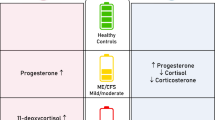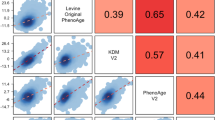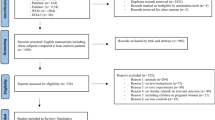Abstract
Summary
In male Caucasians with discordant hip bone mineral density (BMD), we applied the subcellular separation and proteome profiling to investigate the monocytic cytosol. Three BMD-associated proteins (ALDOA, MYH14, and Rap1B) were identified based on multiple omics evidence, and they may influence the pathogenic mechanisms of osteoporosis by regulating the activities of monocytes.
Introduction
Osteoporosis is a serious public health problem, leading to significant mortality not only in aging females but also in males. Peripheral blood monocytes (PBMs) play important roles in bone metabolism by acting as precursors of osteoclasts and producing cytokines important for osteoclast development. The first cytosolic sub-proteome profiling analysis was performed in male PBMs to identify differentially expressed proteins (DEPs) that are associated with BMDs and risk of osteoporosis.
Methods
Here, we conducted a comparative proteomics analysis in PBMs from Caucasian male subjects with discordant hip BMD (29 low BMD vs. 30 high BMD). To decrease the proteome complexity and expand the coverage range of the cellular proteome, we separated the PBM proteome into several subcellular compartments and focused on the cytosolic fractions, which are involved in a wide range of fundamental biochemical processes.
Results
Of the total of 3796 detected cytosolic proteins, we identified 16 significant (P < 0.05) and an additional 22 suggestive (P < 0.1) DEPs between samples with low vs. high hip BMDs. Some of the genes for DEPs, including ALDOA, MYH14, and Rap1B, showed an association with BMD in multiple omics studies (proteomic, transcriptomic, and genomic). Further bioinformatics analysis revealed the enrichment of DEPs in functional terms for monocyte proliferation, differentiation, and migration.
Conclusions
The combination strategy of subcellular separation and proteome profiling allows an in-depth and refined investigation into the composition and functions of cytosolic proteome, which may shed light on the monocyte-mediated pathogenic mechanisms of osteoporosis.


Similar content being viewed by others
Abbreviations
- PBMs:
-
Peripheral blood monocytes
- BMD:
-
Bone mineral density
- DEPs:
-
Differentially expressed proteins
- ALDOA:
-
Aldolase, fructose-bisphosphate A
- MYH14:
-
Myosin, heavy chain 14
- RAP1B:
-
Member of RAS oncogene family
- GSN:
-
Gelsolin
- IL-1:
-
Interleukin-1
- IL-6:
-
Interleukin-6
- TNF-α:
-
Tumor necrosis factor-α
- MS:
-
Mass spectrometer
- PBMCs:
-
Peripheral blood mononuclear cells
- ATP:
-
Adenosine triphosphate
- RANKL:
-
Receptor activator of nuclear factor kappa-B ligand
- UPLC:
-
Ultra performance liquid chromatography
- HDMS:
-
High-definition mass spectrometry
- FA:
-
Formic acid
- ADH1:
-
Alcohol dehydrogenase 1
- GWAS:
-
Genome-wide association studies
- GO:
-
Gene ontology
- GEFOS:
-
Genetic Factors for Osteoporosis Consortium
- FDR:
-
False discovery rate
- DAVID:
-
Database for Annotation, Visualization and Integrated Discovery
- GO:
-
Gene ontology
- PPI:
-
Protein-protein interactions
- STRING:
-
Search Tool for the Retrieval of Interacting Genes/Proteins
- CFL1:
-
Cofilin 1
- FGG:
-
Fibrinogen gamma chain
- CBX3:
-
Chromobox 3
- CALR:
-
Calreticulin
- ACTN1:
-
Actinin alpha 1
- MYL9:
-
Myosin light chain 9
- ACTB:
-
Actin, beta
- HSP90AA1:
-
Heat shock protein 90-kDa alpha family class A member 1
- HSPA5:
-
Heat shock protein family A (Hsp70) member 5
- CAP1:
-
Adenylate cyclase-associated protein 1
- THBS1:
-
Thrombospondin 1
- TCA:
-
Tricarboxylic acid
- LDHAL6A:
-
Lactate dehydrogenase A like 6A
- LDHB:
-
Lactate dehydrogenase B
- TLN1:
-
Talin1
- M-CSF:
-
Macrophage colony-stimulating factor
- NMHC IIC:
-
Non-muscle myosin II heavy chain
- NM II:
-
Muscle myosin II
References
Lin JT, Lane JM (2004) Osteoporosis: a review. Clin Orthop Relat Res 425:126–134
Deng HW et al (2002) A whole-genome linkage scan suggests several genomic regions potentially containing quantitative trait loci for osteoporosis. J Clin Endocrinol Metab 87(11):5151–5159
Center JR et al (1999) Mortality after all major types of osteoporotic fracture in men and women: an observational study. Lancet 353(9156):878–882
Teitelbaum SL (2000) Bone resorption by osteoclasts. Science 289(5484):1504–1508
Liu YZ et al (2005) A novel pathophysiological mechanism for osteoporosis suggested by an in vivo gene expression study of circulating monocytes. J Biol Chem 280(32):29011–29016
Deng FY et al (2014) Is GSN significant for hip BMD in female Caucasians? Bone 63:69–75
Zhou Y, Deng HW, Shen H (2015) Circulating monocytes: an appropriate model for bone-related study. Osteoporos Int 26(11):2561–2572
Deng FY et al (2011) Peripheral blood monocyte-expressed ANXA2 gene is involved in pathogenesis of osteoporosis in humans. Mol Cell Proteomics 10(11):M111 011700
Chen YC et al (2016) Integrative analysis of genomics and transcriptome data to identify potential functional genes of BMDs in females. J Bone Miner Res 31(5):1041–1049
Farber CR (2013) Systems-level analysis of genome-wide association data. G3 (Bethesda) 3(1):119–129
He H et al (2014) Integrative analysis of GWASs, human protein interaction, and gene expression identified gene modules associated with BMDs. J Clin Endocrinol Metab 99(11):E2392–E2399
Lee JH, Cho JY (2014) Proteomics approaches for the studies of bone metabolism. BMB Rep 47(3):141–148
Chen EI et al (2006) Large scale protein profiling by combination of protein fractionation and multidimensional protein identification technology (MudPIT). Mol Cell Proteomics 5(1):53–56
Dreger M (2003) Proteome analysis at the level of subcellular structures. Eur J Biochem 270(4):589–599
Morrison MS et al (1998) ATP is a potent stimulator of the activation and formation of rodent osteoclasts. J Physiol 511(Pt 2):495–500
Kim JM et al (2007) Osteoclast precursors display dynamic metabolic shifts toward accelerated glucose metabolism at an early stage of RANKL-stimulated osteoclast differentiation. Cell Physiol Biochem 20(6):935–946
Liu M et al (1996) Transcriptional activation of the Cdk inhibitor p21 by vitamin D3 leads to the induced differentiation of the myelomonocytic cell line U937. Genes Dev 10(2):142–153
Asada M et al (1999) Apoptosis inhibitory activity of cytoplasmic p21(Cip1/WAF1) in monocytic differentiation. EMBO J 18(5):1223–1234
Hoiberg M et al (2007) Population-based reference values for bone mineral density in young men. Osteoporos Int 18(11):1507–1514
Kirk RE (2013) Experimental design: procedures for the behavioral sciences (4th ed.). Sage Publications, Thousand Oaks, pp. 233–272
Guey LT et al (2011) Power in the phenotypic extremes: a simulation study of power in discovery and replication of rare variants. Genet Epidemiol 35(4):236–246
Ziegler-Heitbrock L, Hofer TP (2013) Toward a refined definition of monocyte subsets. Front Immunol 4:23
Komano Y et al (2006) Identification of a human peripheral blood monocyte subset that differentiates into osteoclasts. Arthritis Res Ther 8(5):R152
Huang da W (2009) B.T. Sherman, and R.A. Lempicki, Bioinformatics enrichment tools: paths toward the comprehensive functional analysis of large gene lists. Nucleic Acids Res 37(1):1–13
Bindea G et al (2009) ClueGO: a Cytoscape plug-in to decipher functionally grouped gene ontology and pathway annotation networks. Bioinformatics 25(8):1091–1093
Szklarczyk D et al (2011) The STRING database in 2011: functional interaction networks of proteins, globally integrated and scored. Nucleic Acids Res 39:D561–D568
Liu YZ et al (2015) Attenuated monocyte apoptosis, a new mechanism for osteoporosis suggested by a transcriptome-wide expression study of monocytes. PLoS One 10(2):e0116792
Zheng HF et al (2015) Whole-genome sequencing identifies EN1 as a determinant of bone density and fracture. Nature 526(7571):112–117
Wang K, Li M, Bucan M (2007) Pathway-based approaches for analysis of genomewide association studies. Am J Hum Genet 81(6):1278–1283
Tyekucheva S et al (2011) Integrating diverse genomic data using gene sets. Genome Biol 12(10):R105
Benjamini Y, Hochberg Y (1995) Controlling the false discovery rate—a practical and powerful approach to multiple testing. J Royal Stat Soc Series B—Methodol 57(1):289–300
Ide R et al (1994) High glucose condition activates protein tyrosine phosphatases and deactivates insulin receptor function in insulin-sensitive rat 1 fibroblasts. Biochem Biophys Res Commun 201(1):71–77
Roiniotis J et al (2009) Hypoxia prolongs monocyte/macrophage survival and enhanced glycolysis is associated with their maturation under aerobic conditions. J Immunol 182(12):7974–7981
Zhang JG et al (2015) Integrative analysis of transcriptomic and Epigenomic data to reveal regulation patterns for BMD variation. PLoS One 10(9):e0138524
Caspi M et al (2014) Aldolase positively regulates of the canonical Wnt signaling pathway. Mol Cancer 13:164
Wei W et al (2011) Biphasic and dosage-dependent regulation of osteoclastogenesis by beta-catenin. Mol Cell Biol 31(23):4706–4719
Yam PT et al (2007) Actin-myosin network reorganization breaks symmetry at the cell rear to spontaneously initiate polarized cell motility. J Cell Biol 178(7):1207–1221
Cai Y et al (2006) Nonmuscle myosin IIA-dependent force inhibits cell spreading and drives F-actin flow. Biophys J 91(10):3907–3920
Vicente-Manzanares M et al (2009) Non-muscle myosin II takes Centre stage in cell adhesion and migration. Nat Rev Mol Cell Biol 10(11):778–790
Muller WA (2011) Mechanisms of leukocyte transendothelial migration. Annu Rev Pathol 6:323–344
Andersen GO et al (2002) Alpha(1)-AR-induced positive inotropic response in heart is dependent on myosin light chain phosphorylation. Am J Physiol Heart Circ Physiol 283(4):H1471–H1480
Licht AH et al (2010) Junb regulates arterial contraction capacity, cellular contractility, and motility via its target Myl9 in mice. J Clin Invest 120(7):2307–2318
Caron E (2003) Cellular functions of the Rap1 GTP-binding protein: a pattern emerges. J Cell Sci 116(Pt 3):435–440
Filippi MD (2015) Leukocyte transcellular diapedesis: Rap1b is in control. Tissue Barriers 3(3):e1052185
Tadokoro S et al (2003) Talin binding to integrin beta tails: a final common step in integrin activation. Science 302(5642):103–106
Zou W et al (2013) Talin1 and Rap1 are critical for osteoclast function. Mol Cell Biol 33(4):830–844
Acknowledgements
This study was partially supported by and/or benefited from grants from National Institutes of Health (P50AR055081, R21AG27110, R01AR057049, R01AR059781) and Edward G. Schlieder Endowment to Tulane University.
This manuscript was not prepared in collaboration with investigators of the Framingham Heart Study (FHS) and does not necessarily reflect the opinions of the FHS, Boston University. The GWA meta-analysis study dataset which used for supportive study in this manuscript was integrated from some individual GWAS datasets. The FHS datasets were obtained from dbGaP at http://www.ncbi.nlm.nih.gov/sites/entrez?db=gap through dbGaP accession phs000007.v14.p6. Assistance with phenotype harmonization and genotype cleaning, as well as with general study coordination, of Genetic Determinants of Bone Fragility study was provided by the NIA Division of Geriatrics and Clinical Gerontology and the NIA Division of Aging Biology. Assistance with phenotype harmonization, SNP selection, data cleaning, meta-analyses, data management, and dissemination and general study coordination, was provided by the PAGE Coordinating Center (U01HG004801-01).
Author information
Authors and Affiliations
Corresponding author
Ethics declarations
Conflicts of interest
None.
Funding source
The Framingham Heart Study is conducted and supported by the National Heart, Lung, and Blood Institute NHLBI in collaboration with Boston University (Contract No. N01-HC-25195). Funding for SHARe Affymetrix genotyping was provided by NHLBI Contract N02-HL-64278. SHARe Illumina genotyping was provided under an agreement between Illumina and Boston University. Funding support for the Framingham BMD datasets was provided by NIH grants R01AR/AG 41398. Funding support for the Genetic Determinants of Bone Fragility (the Indiana fragility study) was provided through the NIA Division of Geriatrics and Clinical Gerontology. Genetic Determinants of Bone Fragility is a genome-wide association studies funded as part of the NIA Division of Geriatrics and Clinical Gerontology. Support for the collection of datasets and samples were provided by the parent grant, Genetic Determinants of Bone Fragility (P01-AG018397). Funding support for the genotyping which was performed at the Johns Hopkins University Center for Inherited Diseases Research was provided by the NIH NIA. The WHI program is funded by the National Heart, Lung, and Blood Institute, National Institutes of Health, U.S. Department of Health and Human Services through contracts N01WH22110, 24152, 32100-2, 32105-6, 32108-9, 32111-13, 32115, 32118, 32119, 32122, 42107-26, 42129-32, and 44221. WHI PAGE is funded through the NHGRI Population Architecture Using Genomics and Epidemiology (PAGE) network (Grant No. U01HG004790).
Electronic supplementary material
Supplementary Table 1
(DOCX 14 kb).
Supplementary Table 2
(DOCX 22 kb).
Supplementary Table 3
(DOCX 17 kb).
Rights and permissions
About this article
Cite this article
Zhu, W., Shen, H., Zhang, JG. et al. Cytosolic proteome profiling of monocytes for male osteoporosis. Osteoporos Int 28, 1035–1046 (2017). https://doi.org/10.1007/s00198-016-3825-y
Received:
Accepted:
Published:
Issue Date:
DOI: https://doi.org/10.1007/s00198-016-3825-y




